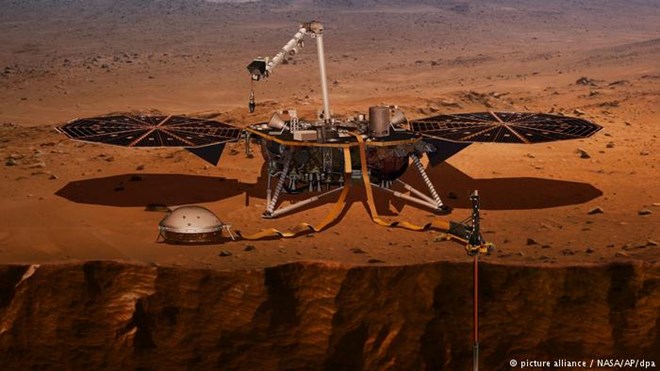
Tuesday November 27, 2018

The unmanned InSight spacecraft has made a successful landing on Mars despite the extreme difficulties involved. The probe aims to collect information on the inside of the planet.
NASA's Mars InSight spacecraft on Monday touched down on the surface of Mars after successfully completing an almost seven-minute-long nail-biting entry, descent and landing phase.
The space craft went from 12,300 mph (19,800 kph) to zero in six minutes flat, using a parachute and braking engines.
The landing, which was greeted with jubilant relief at mission control at Pasadena in the US state of California, is all the more remarkable in light of the fact that less than half of the 43 attempts made so far to reach the Red Planet have succeeded.
There was no immediate word on whether the lander was in good working order, but it managed to send a first image of the surface.
Scientists at the press briefing in Pasadena said that Mars was a great opportunity to study how the earth was formed more than 10 million years ago. Among the questions that they are seeking answer include, "How did mountains and oceans form on earth?"
The InSight mission will also help scientists evaluate whether other planets are habitable.
Scientific mission
The spacecraft, which has cost the US space agency some $993 million (€876.5 million) to develop, build and fly, was launched on May 5, 2018. It is equipped to study geological processes on the planet, including tremors, whether from earthquakes, meteor impacts or volcanic activity.
The stationary 800-pound (360-kilogram) lander will use its 6-foot (1.8-meter) robotic arm to place a mechanical mole and seismometer on the ground. The self-hammering mole — provided by the German Aerospace Center (DLR) — will burrow 16 feet (5 meters) down to measure the planet's internal heat, while the seismometer listens for possible quakes.
"Landing on Mars is one of the hardest single jobs that people have to do in planetary exploration," InSight's lead scientist, Bruce Banerdt, said before Monday's success. "It's such a difficult thing, it's such a dangerous thing that there's always a fairly uncomfortably large chance that something could go wrong."
No lander has dug deeper on Mars than several inches, and no seismometer has ever worked on the planet.
InSight has no life-detecting capability, however. That will be left to future rovers, such as NASA's Mars 2020 mission, which will collect rocks that will eventually be brought back to Earth and analyzed for evidence of ancient life.
The mission is NASA's first attempt to land on Mars, one of Earth's neighboring planets, since the Curiosity rover reached the planet in 2012.